Caballero B. (ed.) Encyclopaedia of Food Science, Food Technology and Nutrition. Ten-Volume Set
Подождите немного. Документ загружается.


test to distinguish fish with ciguatera toxin (apart
from feeding portions to animals such as kittens).
Future Trends
0017 Despite overexploitation of many fish stocks and
consequent (if belated) control measures, it is clear
that fish will continue to play an important role as
food, chiefly as a consequence of improved methods
of farming both of freshwater and marine species. A
better understanding of fish stock management will
be important in keeping capture fisheries at around
present levels, which are probably not far from the
maximum sustainable. In contrast, aquaculture
(which provided 28.8 million tonnes in 1997) will
increase steadily. In 1996, over a quarter of the
world supply of food fish for human consumption
came from aquaculture (mainly Chinese carp and
other cyprinids). It also seems likely that there will
be an increasing amount of fish and fish products
entering international trade, particularly from de-
veloping countries, where exports almost doubled in
value between 1990 and 1995. Future trends here
seem likely to show different methods of keeping
fish free from spoilage such as by the use of controlled
atmosphere packaging using mixtures of N
2
,O
2
,and
CO
2
, and a large increase in the use of such products
as surimi. An entirely different reason for the future
importance of fish as food arises as the result of
dietary studies, which have either demonstrated or
suggested the value of fish diets in preventing some
common diseases in developed countries. For
example, fish are generally low in cholesterol and,
compared to meat, have a much more complex spec-
trum of lipids high in polyunsaturated fatty acids. Of
particular importance is the high proportion of the o-
3 series of fatty acids in oily fish, contrasting with the
o-6 fatty acids of vegetable origin. Epidemiological
studies indicate that significant reductions in coron-
ary heart disease may be obtained by the weekly
consumption of only 300 g of such fish. There are
also possibilities of modifying the diets of farmed
fish to augment the levels of other components valu-
able for the human diet. (See Fish Farming.)
See also: Fatty Acids: Dietary Importance; Fish:
Processing; Miscellaneous Fish Products; Fish Farming;
Preservation of Food
Further Reading
Cato JC (1998) Economic Values associated with Seafood
Safety and Implementation of Seafood Hazard Analysis
Critical Control Point (HACCP) programmes.FAO
Fisheries Technical Paper, Rome: FAO.
Cutting CL (1962) Historical aspects of fish. In: Borgstrom
G (ed.) Fish as Food, vol. 2, pp. 128. London: Academic
Press.
Dean B (1895) Fishes living and fossil. An outline of their
forms and probable relationships. In: Columbia Univer-
sity Biology Series, vol. 3. London and New York: Mac-
millan and Co.
Geiger E and Borgstrom G (1962) Fish protein – nutritive
aspects. In: Borgstrom G (ed.) Fish as Food, vol. 2,
pp. 29–114. London: Academic Press.
Hall GM (ed.) (1997) Fish Processing Technology, 2nd edn.
London: Blackie Academic & Professional.
Halstead BW (1978) Poisonous and Venomous Marine
Animals of the World, p. 1043. Princeton, NJ: Darwin
Press.
Lagler KF, Bardach JE, Miller RR and Passino DRM (1977)
Ichthyology, 2nd edn, pp. 506. Chichester, UK: Wiley.
Catching and Handling
P Chattopadhyay, Jadavpur University, Calcutta,
India
Copyright 2003, Elsevier Science Ltd. All Rights Reserved.
Introduction
0001The devices used to catch fish are known as gear, i.e.,
hooks, baits, nets, and rope. Fishing gear of numerous
designs is available for use in commercial or sport
fishing. Many factors have to be taken into consider-
ation when selecting the method and gear to be used
to catch a particular species of fish in a specific area.
The choice depends on the species being fished, value
of the individual species to the fisherman, the depth of
water, and the characteristics of the sea bed. The
different species of fish have different habits, move-
ments, and reaction to stimuli. Demersal species are
usually found near the sea bed, whereas pelagic
species are found anywhere between the sea bed and
surface. The movements and habits of each species
are controlled by water temperature, salinity, spawn-
ing habits, migration, available food resources, and
the temperature barriers that exist in any particular
location. A few methods of catching fish are discussed
below.
Net Methods
Trawling
0002A fishing method in which a boat is dragging a large
net through the water is called trawling. When the net
is somewhere in the water column, it is called mid-
water trawling, but when the net is dragged along the
2408 FISH/Catching and Handling
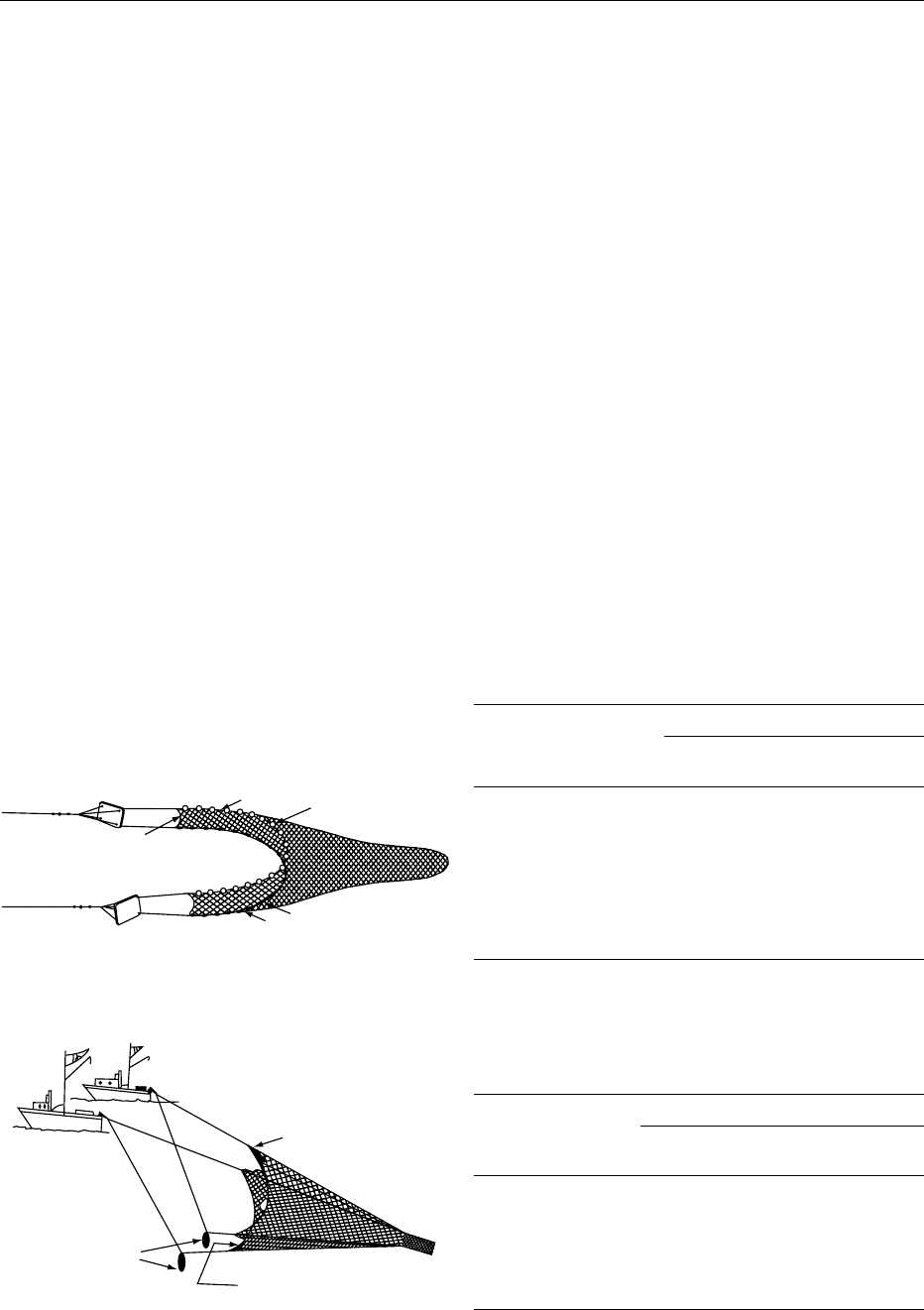
ocean floor it is known as bottom trawling. Many
important species are caught with the bottom trawl.
Large ‘doors’ are used ahead of the net to keep the net
down yet opened wide (Figure 1). There are many
designs of these doors. The most common are otter
doors. Fuel consumption can be reduced by cutting
holes into the doors in appropriate places. Trawling
therefore requires a strong boat to pull the fishing
gear through the water as well as the fish. It disturbs
the bottom of the ocean but is still an efficient method
of catching large quantities of bottom fish. The
doors used for midwater trawls are much lighter
than those used for bottom trawling.
0003 If two boats are used, each dragging one side of the
net, the same opening of the net could be achieved
without using any doors (Figure 2). For this, cooper-
ation between two boats is necessary. Pair trawling is
a fuel-efficient method. The ability of smaller fish to
escape is controlled by the size of the net mesh. How-
ever, as the bag fills up with fish, and the larger fish
block the net holes, small fish become trapped deep
inside the net and are unable to escape. Regulating the
mesh size of the net may be partially effective in
minimizing the catch of undersized fish. Recent re-
search suggests that the shape of the net mesh may
affect its efficiency: a square mesh may allow for
better escape of undersized fish than the traditional
diamond mesh.
0004Table 1 shows some data on the relationship be-
tween fish length and weight. Table 2 relates the mesh
size of a net to the length of fish retained. The lengths
given represent the size at which about 50% of the
fish are retained and 50% can still escape through the
net. The data can also be expressed for a particular
fish (Table 3).
0005The popularity of trawling has been expanded with
the development of factory ships with facilities for
on-board freezing.
Seining
0006Seine nets are often used to catch schooling fish
(Figure 3). Pelagic fish, for example, mackerel, are
most easily caught in this way. These are upper-
water-column fish and swim large distances. Small
boats, sometimes two boats, set off from the mother
ship and carry a relatively small mesh net which is set
around the school of fish. If the net is a ‘purse’ seine, a
string on the bottom is then pulled tight so that the
bottom of the net can be closed off. The net is then
hauled in until most of the fish are in a small area of
water. This is called hardening of the net. The fish are
then removed from the water, with hand nets or with
Swivel
Edge line
Tow line
Otter board
Sinker line
Sinker
Float line
Float
fig0001 Figure 1 An otter trawl net. Reproduced from Yamaha Motors
(1986) Yamaha Fishery Journal Composite, p. 134, with permission.
Floats
Lead weights
Weights
fig0002 Figure 2 Two-boat midwater trawl.
tbl0001Table 1 Optimizing the catch by regulating mesh size
a
: length–
weight data for some common fish
Fish Weight (kg)
0.4 5 0.9 1.3 6
Length (cm)
Pollock 51
Cod 36 48 64
Haddock 38 46 66
Whiting 38 51
Red fish 31 38 51
Mackerel 31 41
Yellow tail 38 46
Rainbow trout 36
a
Mesh size refers to the main part of the net.
Data courtesy of the National Marine Fisheries Service.
tbl0002Table 2 Mesh size (cm) versus retention length (cm) for some
common fish
Mesh size (cm)
10 13 14 16 17
Retention length (50% retained)
Cod 34 45 47 49 56
Haddock 33 43 45 47 53
Yellow tail flounder 22 29 31 32 36
Pollock 34 44 46 48 54
Winter flounder 21 28 29 31 35
Dals (plaice) 24 31 33 34 39
Data courtesy of the National Marine Fisheries Service.
FISH/Catching and Handling 2409
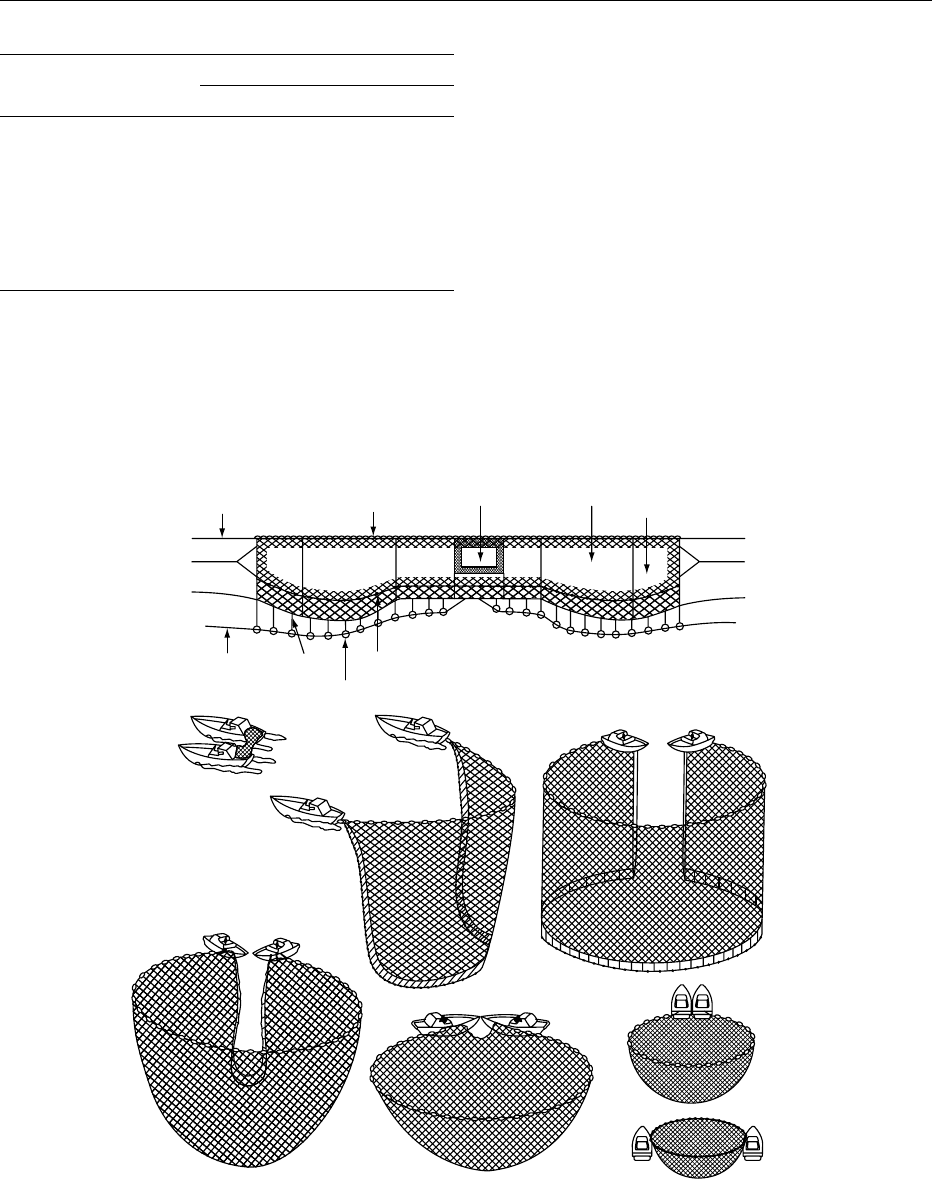
mechanical unloaders (pumps). Purse seining is used
for the capture of species utilized in bulk reduction
processes such as fish meal or species of high value.
The greatest damage is done to the fish at the time of
unloading from the boat because of the postmortem
physicological changes that have occured in the fish.
Fish in rigor should not be pumped. A modification of
the seining method is practiced from the shore. The
mother ship becomes a land-side attachment and the
net, after setting, is hauled to shore by either people
or a vehicle. This method is often used for more
valuable species such as blue fish, striped bass (in
New York), or for salmon (in Scotland).
tbl0003 Table 3 Relative rates of retention for cod
Length (inches) Percent retained
14 cm me sh 15 cm me sh
27 99 97
25 97 98
22 78 56
21.6 74 50
20 53 29
19.8 50 27
18 27 11
16 9 3
Data courtesy of the National Marine Fisheries Service.
1. Sharing the load of a net and moving
forward with their bows linked.
2. Separating from each other and casting
a net where a school of fish is located.
3. Surrounding the school.
4. Pursing begins.
5. and 6. Net hauling.
7. The bunt is positioned between two
boats and fish is scooped with a big dip net.
Holding rope
Purse wire
Operation method
Two-boat purse seining net
Bridle
Purse ring
12 3
4
5
6
7
Lead
Buoy
Bunt
Body
Wing
fig0003 Figure 3 Seine nets. Reproduced from Yamaha Motors (1986) Yamaha Fishery Journal Composite, p. 178, with permission.
2410 FISH/Catching and Handling
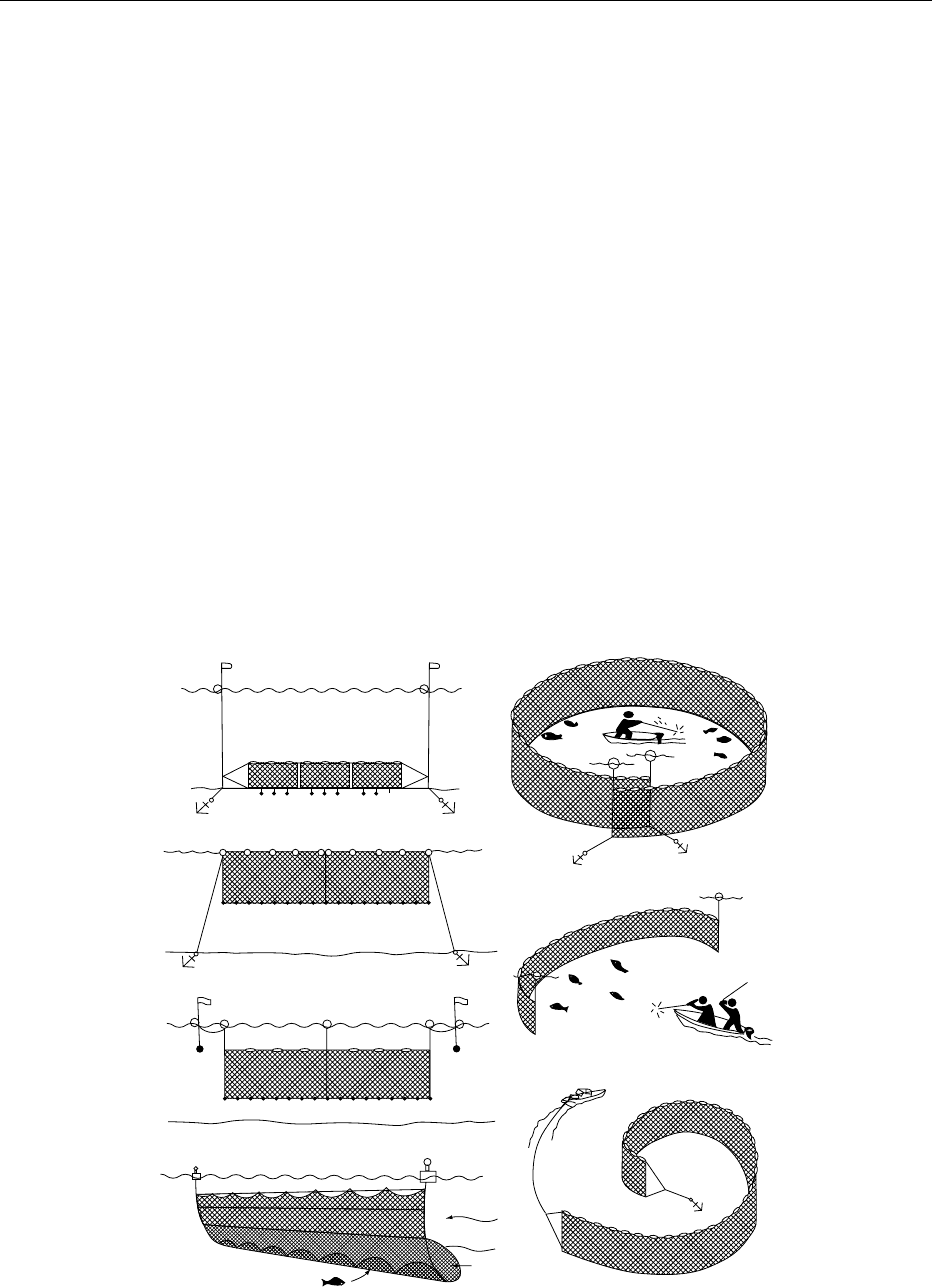
Gillnetting
0007 Gillnetting involves stretching out a net to intercept
fish (Figure 4). The net can be set at any level in the
water column by manipulating the rope length and by
the use of anchors and floats. Placement is often
chosen to intercept natural fish migration. The fish
do not see the net and simply swim into it. Once their
gills go through the net, they can no longer escape,
and they drown. The thrashing of fish prior to death
leads to both external and internal bruising. If the
nets are not well attended, the dead fish will be un-
treated for too long and will be of poor quality. For
this reason, gillnetting is one of the least desirable
ways to catch fish from a quality standpoint, even
though it is extremely efficient. It is an easy method
to use with small boats, for example, for salmon in
Alaska. The nets are generally hauled from one side of
the boat and immediately sent back to fish on the
other side, or a drum is used to wrap the net around
as fish are simultaneously removed by hand.
0008 Gillnetting has become controversial because of
‘ghost fishing’. With modern net materials like nylon,
these nets are difficult for fish to see and may continue
to catch fish after the fisherman has lost them.
Cast Nets
0009Weighted cast nets or variations thereof are usually
used by the artisan fisherman. These are simply
thrown out to sea from land or a small boat; the
weight around the net causes them to sink and trap
(catch) the fish.
Herding devices
0010Another net-based catch method involves the use of
traps, and weirs (Figure 5). These devices herd fish
into an area where they can then be easily removed.
This fixed gear is expensive and time-consuming to
build, and also depends on the fish coming to the trap
rather than a boat going to the fish. Thus, traps work
best when the migration of the desired fish species can
be predicted accurately. They often work best in
rivers or streams or close to the shore where natural
terrain features channel fish movement. The fish can
be caught live simply by hand-netting them out of the
Encircling gill net
Hunting gill net (drive-in net)
Rowing gill net
Bag
net
Bottom drift net
Floating drift net
Fixed-type floating gill net
Anchor
Sinker
Float
Bottom
Water surface
Buoy
Fixed-type bottom gill net
fig0004 Figure 4 Examples of gill and drift nets. Reproduced from Yamaha Motors (1986) Yamaha Fishery Journal Composite, p. 50, with
permission.
FISH/Catching and Handling 2411
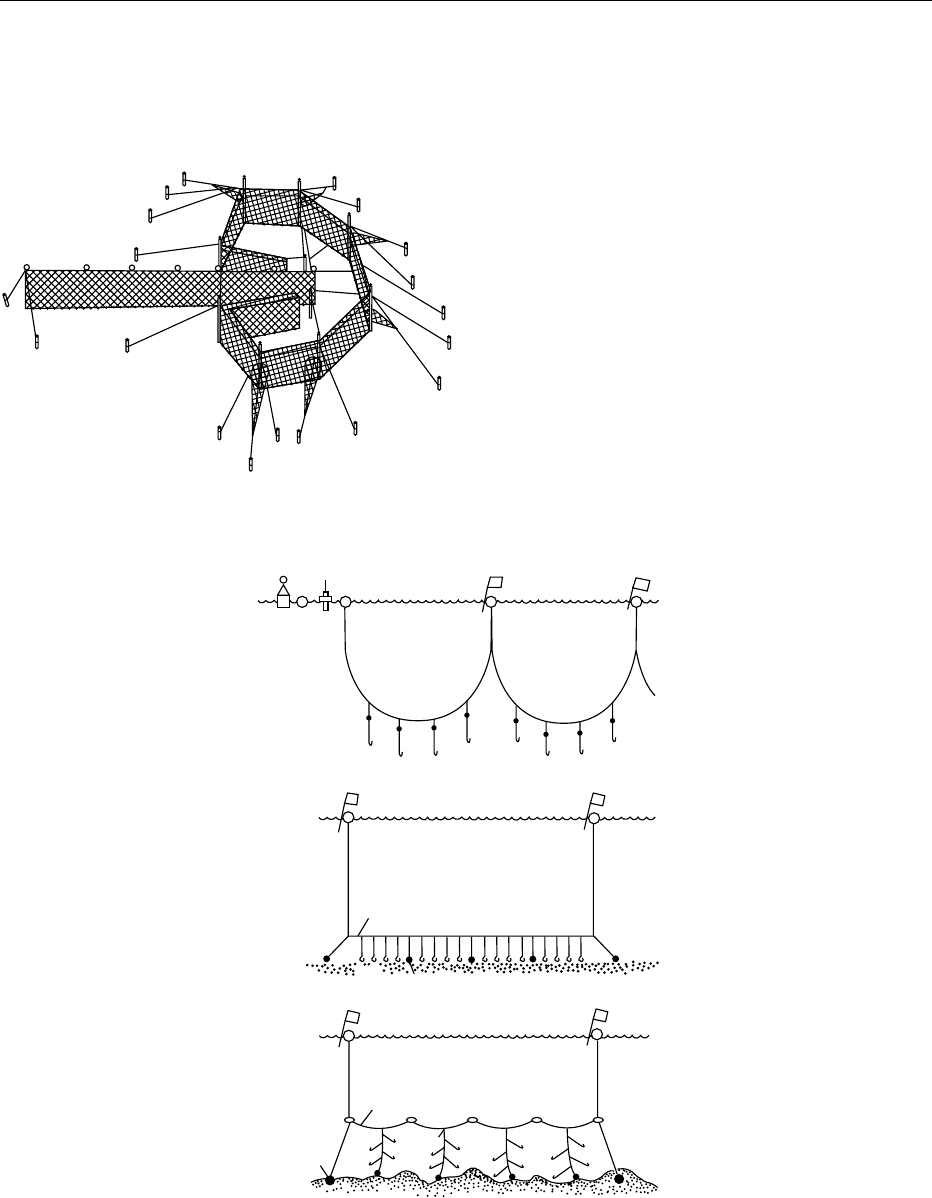
trap. Otherwise fish can be kept alive in the traps for
some time and harvested when needed. Large pound
nets are used along the shore to collect and harvest
these fish.
Hooking Methods
Longlining
0011Longlining is simply the use of a long fishing line with
lots of hooks, usually evenly placed (e.g. every 1 m)
along the line (Figure 6). This method can be used on
rougher grounds (bottoms) where a trawler cannot be
used. This system has many important benefits over
trawling, including the potential for size and species
selectivity by the proper choice of hook size and
shape, and bait; lower energy cost; and less damage
to the ocean bottom.
0012Placing the bait on to numerous hooks is very
labor-intensive. New forms of mechanical baiters
have been developed that replace the tremendous
effort involved in hand baiting. It is also labor-
intensive to remove the bait and fish from the line as
it is hauled back on board. Equipment to do this
automatically has been developed. If longlining is
done properly, the fish can be processed on board
one at a time as they are brought on board.
fig0005 Figure 5 A small fixed net. Reproduced from Yamaha Motors
(1986) Yamaha Fishery Journal Composite, p. 67, with permission.
11
(a)
(b)
(c)
12 10
8
7
1
2
6
5
1
2
6
54
14
10
8
7
1
9
6
14
5
13
1. Trunk line
8. Float 9. Antipressure float
10. Marker fla
g
11. Marker li
g
ht 12. Radio buoy 13. Anchor
2. Branch line 3. Sekiyama 4. Snood 5. Hook
6. Swivel 7. Buoy line
4
2
13
7
10
8
4
3
fig0006 Figure 6 Examples of longlines. (a) Drift longline; (b) bottom longline; (c) vertical line bottom longline. Reproduced from Yamaha
Motors (1986) Yamaha Fishery Journal Composite, p. 219, with permission.
2412 FISH/Catching and Handling

0013 The hooks used for longlining must be of the
appropriate size for the fish that is to be caught. The
choices of hook size and bait make this form of fish-
ing very selective (Figures 7 and 8). Since each hook is
designed to catch fish above a certain size, this tech-
nique is particularly effective in avoiding undersized
fish. Hook shape may also affect species selectivity as
well as the amount of bait needed (a major expense
with longlining). The Mustad Company of Norway
has developed the most advanced longline systems
appearing on the market.
Trolling
0014 Trolling is usually done close to the water surface.
The boat moves through the water with a number of
lines each attached to a pole (Figure 9). A number
of hooks are attached to each line. The fish are almost
always landed live. Trolling allows for selective hand-
ling of fish and thus leads to a very high quality. Troll-
caught salmon are particularly prized, especially if
they are to be smoked subsequently. The absence of
either internal or external bruising maximizes the
appearance and the recovery (weight) of this
extremely expensive product. It must be noted that
subsequent careful handling is important to preserve
the higher initial quality.
Tilefish
Crimson
sea bream
Red sea bream
Bdryx splendens Centrophid fish
Cutlass fishPike congerRayGlobefishFlatfish
Mackerel Yellowtail Halfbeak
Tuna Marlin Shark
fig0007 Figure 7 Various fishing hook shapes. Reproduced from Yamaha Motors (1986) Yamaha Fishery Journal Composite, p. 220.
(a) (b) (c) (d)
fig0008Figure 8 Use of vertical lines. Reproduced from Yamaha
Motors (1986) Yamaha Fishery Journal Composite, p. 211.
FISH/Catching and Handling 2413
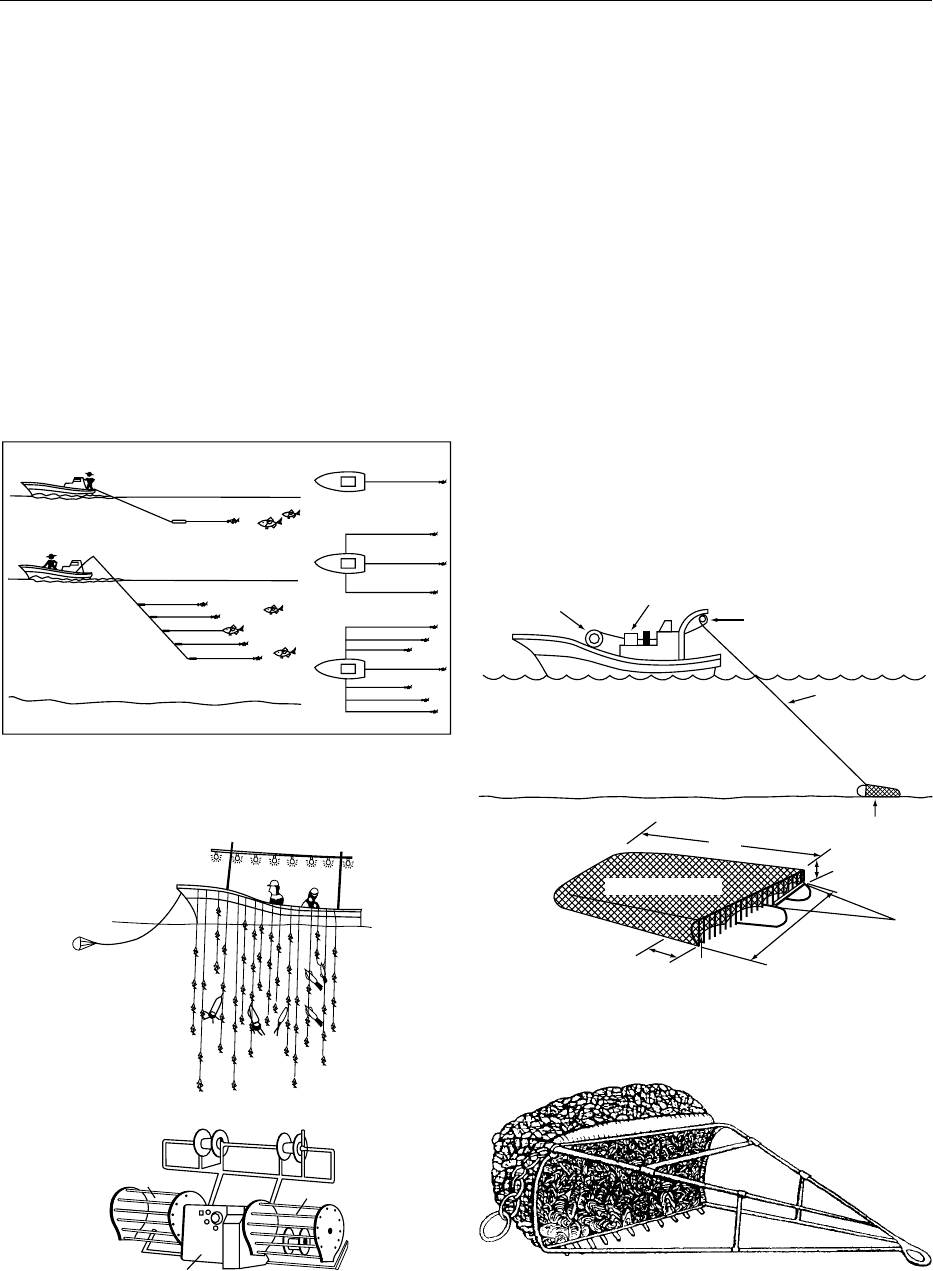
Jigging
0015 Jigging was first developed commercially in Japan.
When fish are caught by this method, bait and/or
special lights (at night) are used to attract the fish to
an area (Figure 10). The fish tend to bite on any
flashing item including the many hooks present in
the water. Some part of the catch may also be snagged
on the hooks. The system of powerful lights on the
boat coupled with brightly colored jigs and small in-
the-water lights is particularly attractive to certain
species of squid. Bait is an important cost in all the
hooking methods, particularly longlining. Each long-
line hook uses about 45 g of bait. Therefore, there is
an interest to develop appropriate baits, i.e., those
that can withstand the physical constrains of the
mechanical system and also attract the appropriate
fish. Research is being done currently on taste prefer-
ences of fish, i.e., flavor attractants. This will help to
develop appropriate artificial baits.
Other Techniques
0016A number of more unusual techniques may also be
used. Spears and harpoons may be used for some of
the larger fish. Fishermen sometimes simply detonate
a bomb in the water and then collect all the dead fish
– usually of low quality. A wide variety of other catch
methods are used for shellfish. These animals often
live below the ocean floor and thus require techniques
like surface dredging (Figures 11 and 12) or raking
and tonging to recover the product (Figures 13 and
14). A dredge has steel teeth that scrape and stir up
the ocean floor. The scallops are then caught in a large
steel bag behind the dredge. Tongs are really a pair of
forks with a center pivot that are used to pick up
clams or oysters from the ocean floor. Classical rod
Surface trolling
One-line trolling
Three-line trolling
Seven-line trolling
Middle-depth trolling
fig0009 Figure 9 Examples of trolling. Reproduced from Yamaha
Motors (1986) Yamaha Fishery Journal Composite, p. 211.
Sea anchor
Reel guide
Drift roller
Windlass
Machine body
fig0010 Figure 10 Automatic squid-fishing jigs. Reproduced from
Yamaha Motors (1986) Yamaha Fishery Journal Composite, p. 24.
Coiling roller
Speed reducer
Pulley
Dredge net
About 200 m
2.2 m
9−12 cm in mesh size
33 cm
2.25 m
Chain
75 cm
2.3 cm
fig0011Figure 11 Operation of a dredge. Reproduced from Yamaha
Motors (1986) Yamaha Fishery Journal Composite, p. 75.
fig0012Figure 12 An oyster dredge. Reproduced from Wheaton FW
and Lawson TB (1985) Processing Aquatic Food Products. New
York: John Wiley, p. 95, with permission.
2414 FISH/Catching and Handling

and reel fishing can be used commercially for larger,
more valuable fish like tuna and swordfish.
0017 There are many other methods used to catch fish as
well as a variety of other types of equipment, such as
pots and traps for shellfish (Figure 15). Most of these
methods are adopted to the specific fish and local
fishing conditions.
0018Traps are often used in areas through which fish
regularly move or congregate. Traps are set in rela-
tively shallow water adjacent to the land. They may
be of many sizes and configurations, but all aim to
prevent fish from leaving once they enter; any vessel
can set and attend a trap.
0019Pots are used to capture crustaceans whose princi-
pal movement is by legs on the sea bed; pot fishing
may be inshore or deep-sea. Pots of different sizes and
configurations are set out and attract the species
by means of baits, either cut-up fish or other sea
creatures, or in a prepared, packaged form. Once
the animal enters the pot through a specially designed
entrance, it is unable to exit again and is trapped.
0020Harpooning can be used commercially on large
species having high individual value. Work and time
involved in searching, capturing, and bringing aboard
each fish restricts the operation to valuable species. A
retrieving line runs from the pole of the harpoon to
the operating vessel; both the hunting and retrieving
lines are run out from coils or tubs positioned on the
vessel’s foredeck.
Handling and Preservation on Ships
0021Handling of fish on ships needs special care. Fish
begin to spoil immediately after death. Since the rate
of spoilage is increased by any rise in temperature, the
refrigeration of the catch by chilling or freezing is
necessary. Spoilage is caused by enzymic, bacterial,
and oxidative changes. Enzymes are present in the
flesh and stomach of the fish, and the gut wall and
the neighboring flesh, which are penetrated and
softened by these enzymes after death, are thus easily
invaded by spoilage bacteria. For this reason, in
trawl, seine, and line fisheries for demersal fish, the
fish is gutted and washed immediately after catching.
In pelagic fisheries, where small fish are caught in
greater numbers and not gutted, the spoilage is
(a)
(b)
fig0013 Figure 13 Oyster tongs. (a) Patent tongs; (b) hand tongs.
Reproduced from Wheaton FW and Lawson TB (1985) Processing
Aquatic Food Products. New York: John Wiley, p. 100, with permis-
sion.
(a)
(c)
(b)
fig0014 Figure 14 Clam rakes. (a/b) Hard clam rakes. (c) Soft shell
clam hoe or fork. Reproduced from Wheaton FW and Lawson TB
(1985) Processing Aquatic Food Products. New York: John Wiley, p.
101, with permission.
fig0015Figure 15 A New England loster pot. Reproduced from
Wheaton FW and Lawson TB (1985) Processing Aquatic Food Prod-
ucts. New York: John Wiley, p. 85, with permission.
FISH/Catching and Handling 2415

quicker. Rancid odors and flavors are produced when
atmospheric oxygen combines with fat in the fish, and
temperature is the most important single factor
affecting the rate of spoilage.
Chilling
0022 The chilling system should maintain the lowest pos-
sible temperature. Considering the problem of qual-
ity, length of voyage, labor, and investment, chilling in
melting ice is the most common method. An alterna-
tive to this is the use of chilled or refrigerated sea
water (CSW or RSW), which has the additional ad-
vantage of handling the catch. The landing deck or
container must be kept clean to prevent contamin-
ation of each haul by previous landings, and constant
attention to hosing the landing deck area is necessary.
Baskets, boots, and other items in contact with the
catch should be thoroughly washed before the fish are
landed. Fish should be carefully handled on the deck
to avoid bruises and cuts; after landing, they are
shifted to holding bins and mixed with ice to cool
them. Gutting is done manually or by automatic gut-
ting equipment on board. Gutting should remove all
the guts and liver, and the belly cavity should be
opened sufficiently to make the washing effective.
After washing, the gutted fish are stored in melting
ice to bleed; this insures that the flesh is free from
discoloration. Chilling of fish in ice is done through
stowage in bulk, in boxes, in pens, or in shelves.
0023 In bulking, the fish and ice are mixed in intimate
contact in order to achieve maximum storage life. It is
carried out in a hold divided into pens fitted with
removable shelves of wood or metal. Bulking to a
depth greater than 40 cm is not recommended and,
with some species, the limits are lower; otherwise,
there would be excessive weight loss owing to the
pressure. With bulking, there are difficulties in
unloading the catch owing to the problem of separat-
ing the ice and the fish, a process which may involve a
large amount of labor. Sometimes, for this reason,
substantial water is added and fish are pumped out
with a centrifugal pump.
0024 The boxing of fish is usually preferred to bulking
because of better cooling, and the elimination of
handling of the fish (bruising and injury) at the
dock, leading to an improved quality of product at
the point of consumption. Boxing involves placing ice
and fish in a container (box) of standard dimensions
(normally 30 and 65 kg capacity) and stowing the box
in the hold. The only real disadvantage is that boxing
requires more hold space per unit weight of fish;
return of reusable boxes may also be a problem.
0025 In the shelf stowage system, the fish is stowed in
single layers, gut cavity down, on a bed of ice. Some-
times a little ice is spread on top. This insures
complete bleeding and retards spoilage by chilling,
but it is a process which is not widely used on vessels
because it is not space-efficient and the fish may
become dehydrated as a result of the movement of
air over the unprotected fish.
0026In pen stowage, fish and ice are placed in alternate
layers to a depth of 70 cm, a second pen board is
placed over the bottom pen, and the same process is
repeated. This storage system is widely used for
stowing fish in ice. In general, crushed or flaked ice
is used in the chilling of fish on board. The storage life
of fish in ice can be slightly extended through the use
of antibiotics or salt-water ice. Antibiotics such as
chlorotetracycline and oxytetracycline in concentra-
tions up to 5 p.p.m. in ice are permitted in some
countries to inhibit bacterial action. Separation of
salt and water during freezing or melting is a problem
with salt-water ice. Immersion of fish in CSW or RSW
is used as an alternative to ice for the chilled storage
of fish. The sea water may be chilled by the direct
addition of ice (CSW), or by mechanical refrigeration
with a heat exchanger (RSW). Storage of fish in CSW
or RSW helps in unloading the fish from the vessel, as
they can be pumped out and into a holding tank.
Freezing
0027Freezing at sea is necessary if the vessel remains at sea
for a period up to 90 days. Storage in ice, or by other
means of chilling, is adequate up to 15 days, after
which the fish rapidly become inedible. If fish are
frozen on board and stored at low temperature, the
fishing vessel can remain at the fishing grounds until
the hold is full. This improves the economics of fish-
ing, and the general quality of fish landed. Depending
on the facilities available on board and the markets,
fish may be frozen in the round, gutted, gutted and
headed, or in the form of fillets. A number of conven-
tional freezers may be used at sea with little modifica-
tion. The freezer and its refrigeration system have to
conform to national regulations and insurance re-
quirements for a fishing vessel. Many countries do
not allow the use of ammonia as a refrigerant in
fishing vessels. The design, operation, and type of
refrigeration system must take into account the move-
ment of the vessel, vibration, sea-water corrosion,
and the extra rough usage under conditions at sea.
Fish to be frozen and iced fish are handled in the same
way, except that the former are frozen rather than
merely cooled. Filleting is the step before freezing,
and the fish should be held at chill temperature,
below 5
C, from catching to freezing, in order to
retard spoilage and avoid the ill-effects of rigor mortis.
0028Rigor mortis, or death-stiffening, is the physical
change that occurs in all animals, including fish, as a
result of a series of complex reactions that go on in
2416 FISH/Catching and Handling

the flesh tissue after death. It is one of the factors
which, after a certain period of time, retards the
postmortem autolytic and bacterial decomposition
of the flesh and its protein, and thus extends the
shelf-life. Rigor mortis in fish starts 1–7 h after
death and its peak in slaughtered fish, kept in ice,
lies between 5 and 22 h after death; the total duration
of the rigor is 30–120 h. A prolongation of the rigor
mortis period is of great economic importance, and
harvesting and on-board handling practices should
aim to extend rigor and maintain fish quality. Rigor
mortis lasts longer when the fish has exerted less
muscular activity prior to death, as it is refrigerated
immediately. Immediate slaughtering of the fish after
capture also appreciably extends rigor. The onset of
rigor mortis is quicker at higher temperatures, and
may occur only 10–20 min after death at about 30
C.
It is therefore essential that the fish is chilled quickly
to avoid problems arising from rigor mortis during
freezing. If possible, it is desirable to freeze fish before
rigor mortis begins. Freezing in rigor can damage the
fish, and only poor-quality frozen fillets or blocks can
be made from such fish. However, while some fish can
be frozen postrigor, others become quite unsaleable.
In addition, prerigor frozen fillets are sometimes
subject to contraction upon thawing; they should be
transferred to the cold store immediately on removal
from the freezer.
Handling in Port
0029 Containers, boxes, and the portable sections of a fish
room are handled by cranes. The discharge of a large
vessel stowing its catch in pens and shelves is achieved
by filling a basket with fish, attaching it to the end of
a rope, hoisting it up and swinging it ashore; this
operation may be mechanized using bucket elevators
and ship-to-shore conveyors. In the chilled or refriger-
ated sea-water systems of stowage, pump unloading
is convenient and widely used. The fish which are
frozen on board are unloaded by standard, endless
looped-canvas elevator belts. After landing, the fish
should not be exposed to warm ambient temperatures
of the auction market. Fish can be sold, after taking
random samples from the boxes, containers, or
shelves, as soon as the vessel arrives in the port, so
that the fish can be unloaded directly on to the
waiting transport. Cleanliness, care, and cooling are
most important for first-class fish.
0030 It is common to land fish at a market (fish pier)
where it is put up for auction. This is also convenient
for the ship and secures maximum prices for the fish.
However, since these auctions can cause delay in the
further distribution of the fish, affecting its quality,
there should be several sales during the day and a
corresponding distribution system (e.g., special fish
trains) to avoid such problems. This will help to
insure that the fish reach inland wholesale or retail
dealers in time for further sale. Fish should always
remain in ice throughout the period in the market,
and special market boxes or kits can be used. Fish
intended for distribution fresh and uprocessed are
usually brought from the market or other landing
points to a packing house. They are iced or reiced
and packed in nonreturnable or returnable containers
with the requisite insulating properties for transport
to the inland wholesaler or retailer.
See also: Fish: Processing; Shellfish: Commercially
Important Crustacea; Spoilage: Chemical and Enzymatic
Spoilage; Bacterial Spoilage
Further Reading
Borgstrom G (ed.) (1961) Fish as Food, vols I and IV. New
York: Academic Press.
Burgess GHO, Cutting CI, Lovern JA and Waterman JJ
(eds) (1965) Fish Handling and Processing. Edinburgh;
Her Majesty’s Stationery Office.
Connell JJ (ed.) (1980) Advances in Fish Science and Tech-
nology. Farnham: Fishing News (Books).
FAO (1997) Freezing in Fisheries. FAO Fisheries technical
paper 167. Rome: Food and Agriculture Organization.
Kristjonssen H (ed.) (1959) Modern Fishing Gear of the
World. Farnham: Fishing News (Books).
Regenstein JM and Regenstein CE (1991) Introduction to
Fish Technology. New York: Van Nostrand Reinhold.
Wheaton FW and Lawson TB (1985) Processing Aquatic
Food Products. New York: John Wiley.
Fish as Food
G Lozano and A Hardisson, University of La Laguna,
Tenerife, Canary Islands, Spain
Copyright 2003, Elsevier Science Ltd. All Rights Reserved.
Background
0001Seafood plays an important role in human nutrition,
contributing near 125 000 million tonnes per annum
of finfish, shellfish-molluscs, shellfish-crustaceans,
and a few other edibles, both from fisheries catch
and from aquaculture production. New technologies
in fish manipulation, conservation, and manufacture
have ensured a constant distribution and high quality
of products all year round, and actual aquaculture
bloom imply the local appearance of new species on
FISH/Fish as Food 2417
